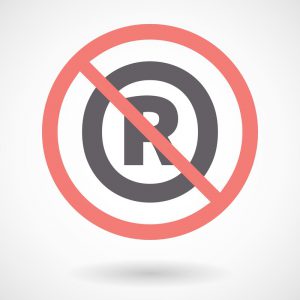 Allow me to share a professional rant. We have to stop listening to the lawyers on this one. Companies are habitually adding registration marks to their news releases. I confess. I have more than one client that requires them. But I have to stop, raise my hand and ask one question. Why?
Allow me to share a professional rant. We have to stop listening to the lawyers on this one. Companies are habitually adding registration marks to their news releases. I confess. I have more than one client that requires them. But I have to stop, raise my hand and ask one question. Why?
The answer I hear is that it is “required” for trademark, service mark, or membership mark protection. It’s a registered word, and we own it. We have to protect our ownership, so put the damn circle “R” at the end of the name. End of story.
But it is not.
The most significant takeaway upfront is this: you will never see a registration mark in the middle of a story in the New York Times, USA Today, Time magazine, or any legitimate print news source.
So, what the heck are we doing littering our news releases with them?
Two Worlds, Different Rules
You see, there is this one world known as journalism. In journalism, the journalists control the message, not the messenger who shares the message with the journalist. That would be me, the PR person you hire to create the news release and share with the journalist.
When we issue a news release, think of it as a message we are sharing with journalists to get them interested in the story you are trying to tell. If we get their attention and they like the story, they will sometimes use portions of the news release. Most often, the news release serves as a reference point.
The other world is advertising. In adverting, the messenger controls the message. You are the advertiser – the messenger – and you paid for the content, so it can say (within reason) just about anything you want it to say. And it can look however you want it to look. You want to put a registration mark every time your registered brand name is mentioned – go for it! And your lawyers will love you.
Causing Confusion
The internet has clouded the world of journalism. The lines between what is advertising and what is journalism are blurring and continues on that path. Because the focus is on driving traffic and engagement, a plethora of psuedo news and information sites are abound on the net. Plus, legitimate news sites need to find new revenue streams, and all of this has given news releases another avenue over the last couple of decades.
Paid news wires, like PR Newswire, GlobeNewswire, BusinessWire and PRWeb feed these pseudo-news sites and special news sections on legitimate news sites (local TV stations and Business Journals, for example). This is one case where a news release is published verbatim, word for word, with every single registration mark included. After all, you paid for the news release to appear as is. That’s why they call it a paid newswire.
It’s Just Not Right
Putting a registration mark on a word in the body text of a news release is wrong. Putting it in a headline is horrid. Now please do not tweet out the ones I have done for clients because that’s what the client requested. Hopefully, this article will advance reconsideration.
My fear is we all look bad when we do this. We look wrong to the journalist. It inhibits their use of a news release. We also look bad to the consumer or other target audience, because sticking that registration mark makes editorial copy look more like ad copy. That’s the reverse of what we are trying to accomplish for our clients.
Moreover, I fear that as the internet gets smarter, even the pseudo-news sites will not publish news releases with too many registration marks. They will treat it as Spam.
A Better Approach
NAR published what I thought was an excellent policy on the use of trademarks in news releases years ago. It is still in their most recent Trademark manual. The language mentions the all but defunct UPI, so that it tells you how long it has been around. But here is what it says:
“News Releases May Use the AP or UPI Style: Most newspapers follow either the Associated Press (AP) Style Book or the United Press International (UPI) Style Book in preparing news items for publications. These style books do not call for use of full capitals or a federal registration symbol “®” for registered marks. Therefore, it is permissible for a Member Board or member to follow the AP or UPI guidelines when using a MARK in a news release.”
AP, in fact, does not use either the TM symbol or ® in any of its news copy but instead, will capitalize or use an initial cap. The NAR requires this final compromise: “News releases should include the definition of the term REALTOR® at the bottom of each page.”
But here is the final irony. NAR news releases currently do not follow this guideline and have lots of registration marks.
Please, everyone, stop the circle “R” madness. Remove them from your news releases; they don’t belong.





OK by me.
Kevin – thank you for the reminder. You’re making us all better with your ‘rants’ on best practices in PR. Please keep them coming.
Amen!